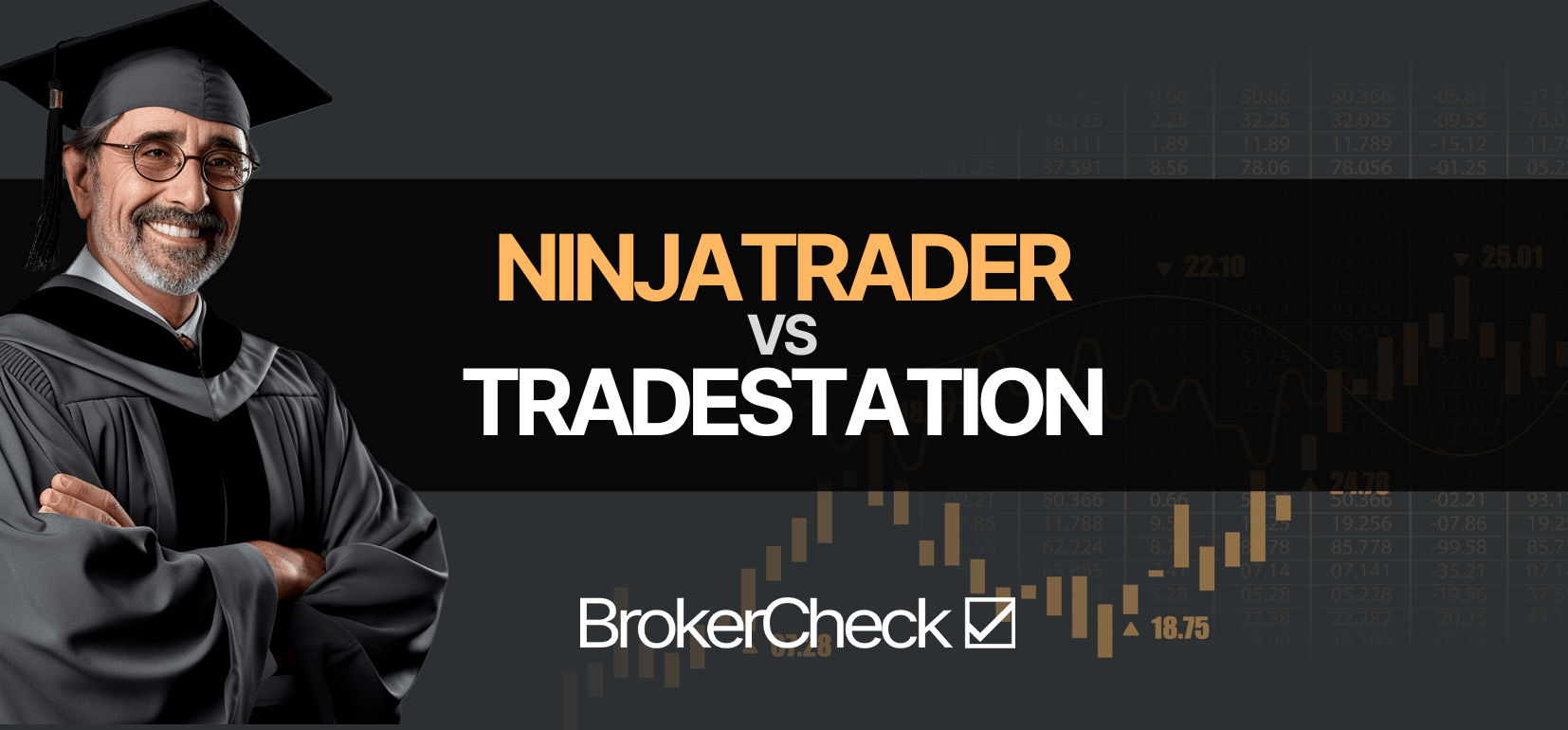1. Trading Platform
A trading platform is the core software that traders use to access the markets, execute orders, analyze charts, and manage their accounts. A good trading platform should be reliable, fast, user-friendly, and cost-effective. The following are the features that differentiate both platforms:

1.1. User Interface and Ease of Use
The user interface and ease of use of a trading platform can have a significant impact on the trading experience and performance. A well-designed user interface should be intuitive, customizable, and responsive. It should also provide easy access to the most important features and functions of the platform.
NinjaTrader has a modular design, which means that traders can open multiple windows and arrange them according to their preferences. Each window can display different types of information, such as charts, order entries, market analyzers, news, etc. NinjaTrader also allows traders to create custom workspaces and save them for future use.

TradeStation:
TradeStation, on the other hand, has a more integrated design, meaning traders can access most of the features and functions from a single main window. The main window consists of several tabs, such as charts, matrix, scanner, radar screen, etc. Each tab can display different types of information, such as charts, order entries, etc. TradeStation also allows traders to create custom layouts and save them for future use.
Both platforms offer a high degree of customization and personalization. Traders can adjust the colors, fonts, sizes, and positions of various elements on the screen. They can also add or remove toolbars, menus, buttons, and indicators. However, some traders may find NinjaTrader more flexible and versatile, while others may prefer TradeStation’s more streamlined and simplified approach.

Both platforms also have a learning curve, especially for beginners. Traders need to familiarize themselves with each platform’s features, functions, and terminology. They also need to learn how to navigate, configure, and operate the platform. Both platforms provide tutorials, videos, and guides to help traders get started.
Here is a table that summarizes the main differences between NinjaTrader and TradeStation in terms of user interface and ease of use:
| Aspect | NinjaTrader | TradeStation |
| Design | Modular | Integrated |
| Customization | High | High |
| Learning Curve | Steep | Moderate |
1.2. Charting Capabilities and Customization
Charting is one of the most essential features of a trading platform. Charts allow traders to visualize various markets and instruments’ price movements and patterns. Charts also enable traders to apply technical analysis, which is the study of past price behavior to predict future price movements and trends.
Both NinjaTrader and TradeStation offer advanced charting capabilities and customization options. Traders can choose from a variety of chart types, such as candlestick, bar, line, area, renko, heikin-ashi, etc. They can also adjust the charts’ time frames, scales, and intervals. Both platforms allow traders to create multiple charts and link them together for easy switching and synchronization. However, there are some differences between the two platforms in terms of charting features and functionalities.
NinjaTrader:
NinjaTrader has a more powerful and flexible charting engine, which allows traders to create custom chart styles, indicators, and strategies. NinjaTrader also supports multi-timeframe and multi-instrument analysis, which means that traders can overlay different time frames and instruments on the same chart. NinjaTrader also has a unique feature called Chart Trader, which allows traders to place and manage orders directly from the chart.

TradeStation:
TradeStation, on the other hand, has a more user-friendly and intuitive charting interface, which allows traders to access and modify the chart settings and indicators easily. TradeStation also has a feature called EasyLanguage, which allows traders to create custom indicators and strategies using a simple programming language. Additionally, it has another perk called RadarScreen, which allows traders to monitor and scan multiple markets and instruments in real-time.

Both platforms offer a large library of pre-built technical indicators, such as moving averages, oscillators, trend lines, etc. They also allow traders to create their own custom indicators using their respective programming languages. However, some traders may find NinjaTrader more versatile and robust, while others may find TradeStation more accessible and convenient.
Here is a table that summarizes the main differences between NinjaTrader and TradeStation in terms of charting capabilities and customization:
| Aspect | NinjaTrader | TradeStation |
| Chart Types | Many | Many |
| Time Frames | Many | Many |
| Custom Chart Styles | Yes | No |
| Multi-Time Frame Analysis | Yes | No |
| Multi-Instrument Analysis | Yes | No |
| Chart Trader | Yes | No |
| EasyLanguage | No | Yes |
| RadarScreen | No | Yes |
| Pre-Built Indicators | Many | Many |
| Custom Indicators | Yes | Yes |
1.3. Technical Indicators and Backtesting Tools
Technical indicators are mathematical calculations that are applied to the price and volume data of a market or instrument. Technical indicators help traders to identify trends, patterns, signals, and opportunities in the market. Technical indicators can be classified into different categories, such as trend, momentum, volatility, volume, etc.
Backtesting is the process of testing a trading strategy or system on historical data to evaluate its performance and profitability. Backtesting helps traders to optimize, refine, and validate their trading ideas and assumptions. Backtesting can also help traders avoid overfitting, curve-fitting, and data-mining biases.
Both NinjaTrader and TradeStation offer a wide range of technical indicators and backtesting tools. Traders can choose from hundreds of pre-built indicators that are available on each platform. They can also create their own custom indicators using their respective programming languages. Both platforms allow traders to apply multiple indicators on the same chart and adjust their parameters and settings. However, there are some differences between the two platforms in terms of technical indicators and backtesting tools.
NinjaTrader:
NinjaTrader has a more advanced and sophisticated backtesting engine, which allows traders to perform historical, walk-forward, and Monte Carlo simulations. NinjaTrader also supports genetic and multi-objective optimization, which means that traders can find the optimal combination of parameters and objectives for their strategies. NinjaTrader also has a feature called Strategy Analyzer, which allows traders to analyze and compare the performance and statistics of their strategies.
TradeStation:
Tradestation, on the other hand, has a more simple and straightforward backtesting interface, which allows traders to perform historical and walk-forward testing. TradeStation also supports single-objective optimization, which means that traders can find the optimal value of one parameter or objective for their strategies. TradeStation also has a feature called Strategy Performance Report, which allows traders to view and export the performance and statistics of their strategies.
Here is a table that summarizes the main differences between NinjaTrader and TradeStation in terms of technical indicators and backtesting tools:
| Aspect | NinjaTrader | TradeStation |
| Pre-Built Indicators | Hundreds | Hundreds |
| Custom Indicators | Yes | Yes |
| Historical Testing | Yes | Yes |
| Walk-Forward Testing | Yes | Yes |
| Monte Carlo Testing | Yes | No |
| Genetic Optimization | Yes | No |
| Multi-Objective Optimization | Yes | No |
| Strategy Analyzer | Yes | No |
| Strategy Performance Report | No | Yes |





1.4. Order Execution Speed and Reliability
Order execution speed and reliability are crucial factors for active traders who trade frequently and in large volumes. Order execution speed refers to how fast a trading platform can send, receive, and execute orders in the market. Order execution reliability refers to how consistent and accurate a trading platform can execute orders according to the trader’s instructions and expectations.
Both NinjaTrader and TradeStation offer fast and reliable order execution capabilities. Traders can choose from a variety of order types, such as market, limit, stop, stop limit, trailing stop, etc. However, there are some differences between the two platforms in terms of order execution speed and reliability.
NinjaTrader:
NinjaTrader has a more direct and efficient order routing system, which allows traders to connect to multiple brokers and data providers. NinjaTrader also supports server-side order management, which means that orders are stored and executed on the broker’s server rather than on the trader’s computer. This reduces the risk of order failures due to network or hardware issues.
TradeStation:
Tradestation, on the other hand, has a more proprietary and centralized order routing system, which means that traders have to use TradeStation as their broker and data provider. It also supports client-side order management, which means that orders are stored and executed on the trader’s computer rather than on the broker’s server. This increases the dependency and vulnerability of the trader’s system.
Here is a table that summarizes the main differences between NinjaTrader and TradeStation in terms of order execution speed and reliability:
| Aspect | NinjaTrader | TradeStation |
| Order Types | Many | Many |
| Advanced Order Features | Yes | Yes |
| Order Interfaces | Many | Many |
| Order Routing System | Direct | Proprietary |
| Order Management | Server-Side | Client-Side |
| Order Execution Speed Testing | Yes | Yes |
1.5. Paper Trading and Simulation Features
Paper trading and simulation allow traders to trade with virtual money and simulated market conditions while still using the same features and functions of the trading platform.
Both NinjaTrader and TradeStation offer paper trading and simulation features. Traders can create and use paper trading accounts separate from their live trading accounts. However, there are some differences between the two platforms in terms of paper trading and simulation features.
NinjaTrader:
NinjaTrader has a more realistic and comprehensive simulation engine, which allows traders to simulate different market scenarios, such as slippage, commissions, latency, etc. NinjaTrader also supports replay mode, which allows traders to replay historical market data and trade as if it were live. NinjaTrader also has a feature called Market Replay, which allows traders to download and replay market data from various brokers and data providers.
TradeStation:
TradeStation, on the other hand, has a more basic and limited simulation engine, which does not account for some market factors, such as slippage, commissions, latency, etc. TradeStation also does not support replay mode, which means that traders can only trade with real-time or delayed market data. TradeStation also does not have a feature like Market Replay, which means that traders can only use the market data provided by TradeStation.
Here is a table that summarizes the main differences between NinjaTrader and TradeStation in terms of paper trading and simulation features:
| Aspect | NinjaTrader | TradeStation |
| Paper Trading Accounts | Yes | Yes |
| Paper Trading Settings | Same as Live | Same as Live |
| Paper Trading Mode | Easy to Switch | Easy to Switch |
| Simulation Engine | Realistic | Basic |
| Replay Mode | Yes | No |
| Market Replay | Yes | No |
| Historical Market Data | Varies | Varies |
2. Asset Classes and Markets
Asset classes and markets are the types of financial instruments and exchanges that traders can trade on a trading platform. Asset classes and markets have different characteristics, such as liquidity, volatility, leverage, margin, etc.
Both NinjaTrader and TradeStation offer access to a wide range of asset classes and markets. Traders can trade mainly futures, options, and forex on both platforms. However, there are some differences between the two platforms in terms of asset classes and markets.
NinjaTrader:
NinjaTrader has a more flexible and open platform, which allows traders to connect to multiple brokers and data providers. NinjaTrader also supports the trading of micro futures, which are smaller contracts that require less capital and risk. The platform also has a SuperDOM feature, which allows traders to view and trade any instrument’s market depth and order book.
TradeStation:
TradeStation, on the other hand, has a closed platform, which means that traders have to use TradeStation as their broker and data provider. TradeStation also does not support trading of micro futures, meaning that traders must trade the standard contracts that require more capital and risk. However, it has a feature called Matrix, which allows traders to view and trade the market depth and order book of any instrument.
Here is a table that summarizes the main differences between NinjaTrader and TradeStation in terms of asset classes and markets:
| Aspect | NinjaTrader | TradeStation |
| Futures | Yes | Yes |
| Options | Yes | Yes |
| Forex | Yes | Yes |
| Stocks | Yes (with limitations) | Yes (with limitations) |
| ETFs | Yes (with limitations) | Yes (with limitations) |
| Exchanges | Many | Many |
| Brokers | Many | One |
| Data Providers | Many | One |
| Micro Futures | Yes | No |
| SuperDOM | Yes | No |
| Matrix | No | Yes |
| Market Data | Varies | Varies |
3. Fees and Commissions
Fees and commissions are the costs that traders have to pay to use a trading platform and access the markets. Fees and commissions can significantly impact the profitability and performance of traders, especially for active traders who trade frequently and in large volumes.
Both NinjaTrader and TradeStation charge fees and commissions for their services and products. Traders have to pay trading commissions for each trade they execute on the platform. However, there are some differences between the two platforms in terms of fees and commissions.
NinjaTrader:
NinjaTrader has a more competitive and transparent pricing structure, which allows traders to choose from different commission plans and pricing options. NinjaTrader also offers a free lifetime license for its platform, meaning traders can use it without paying any platform fees. Moreover, it also provides free real-time and historical market data for some asset classes and markets.
TradeStation:
TradeStation, on the other hand, has a more complex and variable pricing structure, which depends on the type of account, asset class, market, and trading activity. TradeStation also charges a platform fee for using its platform, which can be waived or reduced depending on the trading volume and account balance.
Here is a table that summarizes the main differences between NinjaTrader and TradeStation in terms of fees and commissions:
| Aspect | NinjaTrader | TradeStation |
| Trading Commissions | Varies | Varies |
| Account Fees | None | Varies |
| Platform Fees | None | Varies |
| Add-ons | Varies | Varies |
| Data Feeds | Varies | Varies |
| Discounts and Promotions | Yes | Yes |
4. Research and Education
Research and education are important features for traders who want to stay updated and informed about market trends and developments. It helps traders to learn new skills and strategies and improve their trading performance and results.
Both NinjaTrader and TradeStation offer research and education features. Traders can access and use various research tools and resources that are available on each platform. They can also participate and learn from webinars, tutorials, and educational content that are provided by each platform. However, there are some differences between the two platforms in terms of research and education features.
NinjaTrader:
NinjaTrader has a more focused and specialized research and education platform mainly oriented towards futures and forex trading. NinjaTrader also has a feature called NinjaScript, which allows traders to create custom indicators, strategies, and add-ons using a C#-based programming language. It also has a feature called NinjaTrader Ecosystem, which is a network of third-party developers, educators, and consultants.
TradeStation:
Tradestation, on the other hand, has a more comprehensive and diversified research and education platform, which covers various asset classes and markets. TradeStation also has a feature called EasyLanguage, which allows traders to create custom indicators and strategies. It also has another feature called TradeStation University, which is an online learning center that offers courses, videos, articles, and events.
Here is a table that summarizes the main differences between NinjaTrader and TradeStation in terms of research and education features:
| Aspect | NinjaTrader | TradeStation |
| Research Tools | Varies | Varies |
| Research Resources | Varies | Varies |
| Webinars | Yes | Yes |
| Tutorials | Yes | Yes |
| Educational Content | Yes | Yes |
| External Partnerships | Yes | Yes |
| NinjaScript | Yes | No |
| EasyLanguage | No | Yes |
| NinjaTrader Ecosystem | Yes | No |
| TradeStation University | No | Yes |
5. Community and Support
Community and support also help traders solve any issues or problems that they may encounter while using the trading platform. It can be classified into different categories, such as user forums, community support, customer service, and user experiences.
Both NinjaTrader and TradeStation offer community and support features. Traders can access and join various user forums and communities that are available on each platform. They can also receive and provide community support and feedback from other traders and experts. However, there are some differences between the two platforms in terms of community and support features.
NinjaTrader:
NinjaTrader has a more active and helpful user forum and community, which is moderated and supported by the official NinjaTrader support team. You also get access to the Support Forum, which is a dedicated forum for users to ask and answer questions, report and resolve issues, and request and suggest features.
TradeStation:
TradeStation, on the other hand, has a more passive and limited user forum and community, which is not moderated or supported by the official support team. TradeStation does not offer features like NinjaTrader Support Forum or NinjaTrader Ecosystem, which means that users have to search and find third-party products and services for TradeStation users.
Here is a table that summarizes the main differences between NinjaTrader and TradeStation in terms of community and support features:
| Aspect | NinjaTrader | TradeStation |
| User Forums | Active | Passive |
| Community Support | Helpful | Limited |
| Customer Service | Friendly | Efficient |
| User Experiences | Reliable | Convenient |
| NinjaTrader Support Forum | Yes | No |
| NinjaTrader Ecosystem | Yes | No |










